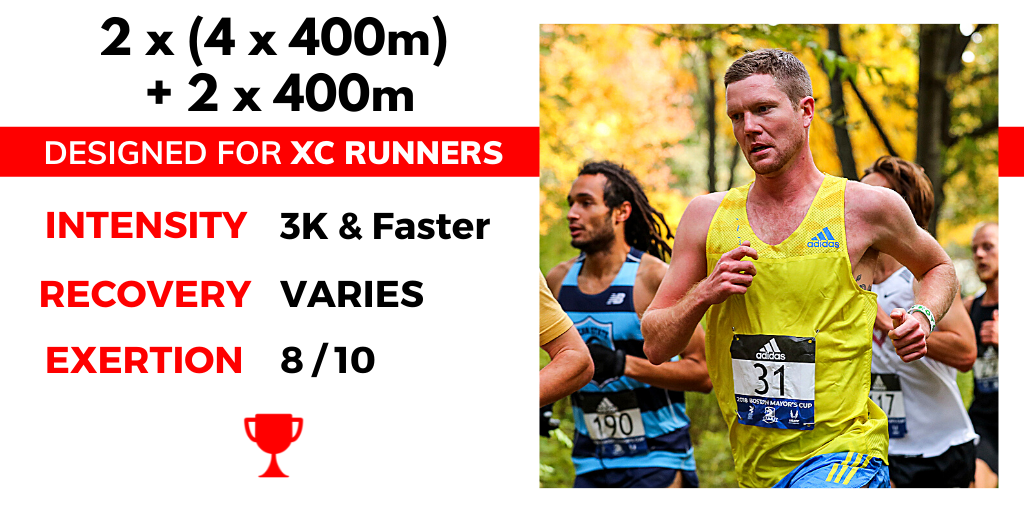2 x (4 x 400m) + 2 x 400m
2 x (4 x 400m) + 2 x 400m
Designed for XC runners
Intensity
1st set at 3K pace
2nd set at 1 Mile pace
1st of 2 x 400m at A.U.G., 2nd 400m at WTF
Recovery
100m jog between 400s in 1st set
200m walk/jog between 400s in 2nd set
3 - 5 minutes walk between A.U.G. & WTF 400s
3 - 6 minutes between sets, as needed
Exertion
8/10
Periodization
Performance Period
Context & Details
During the Performance Period, the only physical quality that should be actively trained, or better though as a refined, is Aerobic Power.
For performance-driven runners, increasing Aerobic Power is the entire purpose of all training.
This is what Lydiard meant when he said what most runners lack is stamina, not speed. It’s a famous line but often misinterpreted.
In a prior WOTD post, I explained what Aerobic Power is and simplistic words like endurance, speed, and speed-endurance that are commonly used to (inappropriately) explain it. Too many have a concept of Aerobic Power similar to Lactic Acid — wrong and outdated, at best.
When you understand Aerobic Power, you understand how to train.
Aerobic Power is the amount of force and speed (Power) a runner can apply fueled primarily by the Aerobic energy system. Lydiard called running in an aerobic state running in a “tireless state.” And to him was the holy grail of distance running training and competitive preparedness.
Although the Aerobic Power concept is simple, how to advance it is not always a direct path and requires harmonizing a variety of different training inputs throughout the preparation process.
If you want better results by learning more about Aerobic Power training methods, Join the Running Scholar Program for only $29 to get unlimited access to courses on this topic plus real-world examples from 100+ training logs of elite runners.
Aerobic Power workouts are characterized by faster than race pace speeds performed on very short recovery intervals.
Today’s session is ideal for XC runners in the performance period and obeys the Get Better Principle of training runners to Run Faster, for Longer.
The beauty of 400m reps is their versatility. You can run one or multiple in a powerful way.
A single 400m rep, run at 800m pace or faster, is considered a Glycolytic Power exercise. Bundling a handful of 400m together with super short recovery intervals, like the first 2 sets of today’s of 400s, is an Aerobic Power exercise.
The difference between the two is Glycolytic Power work is fueled by the Anaerobic energy system and results in very high blood lactate levels, >8 mmol, and heart rate, >180 bpm. Think near maximal effort running you can hold for about 60 seconds. The work to rest ratio is 1:4-5.
Aerobic Power, as mentioned earlier, is fueled by the Aerobic energy system with a blood lactate level of between 4-8 mmol, and a heart rate between 140-180 bpm. The work to rest ratio is 1:1-0.5.
The top priority of power workouts is to maintain the designated pace (power = force x speed) throughout the session. Slower running is less powerful since less force is being exerted each step, and does not provide the desired training reaction. It’s OK to turn an Aerobic Power (short rest intervals) workout into a Glycolytic Power (long rest intervals) session to keep the integrity of the pace. If this happens, ask the runner to perform less overall workout volume and budget in an extra day of recovery so the nervous system can fully rebound.
The 2nd to last 400m of the workout, the A.U.G. 400m, is run at an All You Got finishing burst effort to rehearse expressing high rates of power when fatigued, like the end of a race.
The WTF 400m is a little different.
Not every runner is the “hunter” down the homestretch on race day. Sometimes they’re the hunted. And they should know how to handle themselves in that situation.
The WTF 400m is designed to teach runners to hang on and slow their rate of slow down at the end of the race.
Here’s how you perform it: Have runners run the first 200m at 400m 4x4 effort, and then hang on. About 20m - 100m after passing 200m a flood of lactate will enter their bloodstream and their brain will go, “WTF?!?!” and start the hydrogen-fueled chemical cascade resulting in acidosis and a sharp slowdown.
Encourage the runners not to fight it and tie up by trying harder and compounding the fatigue. Instead, give them clear technical cues, like “slamming the leg down” onto the ground or “pulling the arms back” each stride to get into a better postural position so more facial (non-caloric aka free, elastic) energy is engaged in their running technique.
If done with teammates, to make the slowdown sufferest more fun compete to see who can run the first 200m fastest and slow down the least the final 200m the least.
The fatigue residuals felt from this session should only be acute, meaning lasting less than 24 hours.
After some light post-workout jogging, hydration, dinner, and good night’s sleep the runner should be ready to go again the next day. If not, then the workout was run harder than intended and next time the paces, not the rest intervals, should be adjusted as appropriate.
Any questions? Direct Message me on twitter.
Thx. | jm
Get Better Results with The Running Scholar Program.
Join the Running Scholar Program for $29 to learn more about successful Cross Country Training and get unlimited access to courses and training programs on Cross Country running.
3 Good Books on XC / Race Readiness training
Will it Make the Boat Go Faster? by Ben Hunt-Davis & Harriet Beveridge
Run with the Best by Tony Benson & Irv Ray
Marty Liquori's Guide for the Elite Runner by Marty Liquor & John L. Parker


